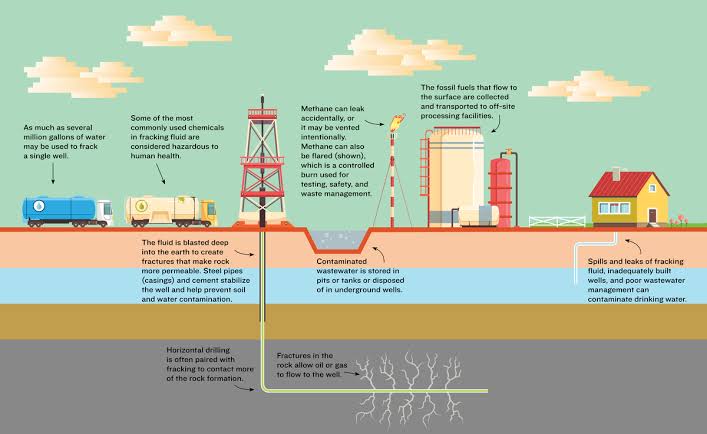W.B.C.S. Examination Notes On – Geology – Fracking.
Geology a branch of Earth Sciences, has risen as one of the most secure and scoring optional subject for the W.B.C.S. Civil Services Mains examination. This subject is easy to understand, hence easy to crack. So, if the aspirants have profound interests in geology, then choose this subject. The syllabus of geology for W.B.C.S. Mains exam is long and aspirants may require over three months covering the syllabus.Fracking, also spelled fracing or fraccing, also called hydrofracking, in full hydraulic fracturing, in natural gas and petroleum production, injection of a fluid at high pressure into an underground rock formation in order to open fissures and allow trapped gas or crude oil to flow through a pipe to a wellhead at the surface.Continue Reading W.B.C.S. Examination Notes On – Geology – Fracking.
Employed in combination with improved techniques for drilling horizontally through selected rock layers, fracking has opened up vast natural gas deposits in the United States and elsewhere. At the same time, the rapid rise of the practice, frequently in regions with no history of intensive oil and gas drilling, has raised concerns over its economic and environmental consequences.
The technology of fracking has been in use since the 1940s, when liquids such as gasoline and crude oil were injected into poorly performing gas and oil wells in the central and southern United States with the aim of increasing their flow rate. Over the following decades, techniques were improved—for instance, treated water became the preferred fracturing medium, and finely graded sand or synthetic materials were adopted as a “proppant” to hold open the fractures.
However, fracking did not enter its current modern phase until the 1990s, when the use of new steerable drill bit motors and electronic telemetering equipment allowed operators to direct borehole drilling and monitor the fracturing process with great precision. Shortly after, a market favourable for natural gas began to be created by high crude oil prices and by environmental regulations that discouraged the burning of oil and coal. In response to these conditions, developers began to open up so-called unconventional gas reservoirs—rock formations that previously had been left undeveloped because, under older production methods, they released the gas contained in them too slowly or in too small a quantity to be profitable.
Gas from unconventional deposits includes coal bed methane (gas located in the joints and fractures of coal seams), “tight gas” (gas locked into relatively impermeable sandstone or limestone formations), and shale gas (gas incorporated into dense microporous shales). Fracking has been used to recover all these gas types, but it has been practiced most prominently in recovering shale gas.
Most gas shales are found in extensive seams hundreds or thousands of metres beneath the surface. These seams can be accessed through conventional vertical drilling, but the most productive method is usually horizontal drilling. In this technique a well is begun in the traditional way, with the auguring of a pilot hole usually some 6 to 15 metres (20 to 50 feet) deep. This is lined with a steel pipe some 40 to 50 cm (16 to 20 inches) in diameter, called the conductor casing, that is cemented into place. From there the borehole is drilled straight down, passing through numerous rock layers that may include contaminable freshwater aquifers used for private wells or municipal water supply. This portion of the borehole is lined with a cemented steel pipe called the surface casing. Depending on production needs or environmental regulations, another pipe, called the intermediate casing, may be cemented inside the surface casing.
Please subscribe here to get all future updates on this post/page/category/website


 Toll Free 1800 572 9282
Toll Free 1800 572 9282  mailus@wbcsmadeeasy.in
mailus@wbcsmadeeasy.in



















































































































